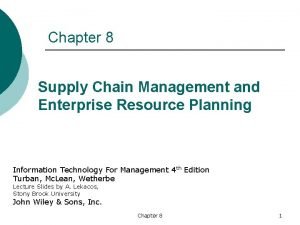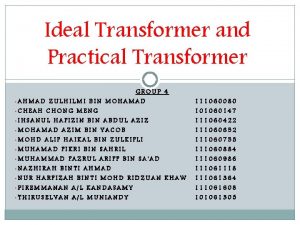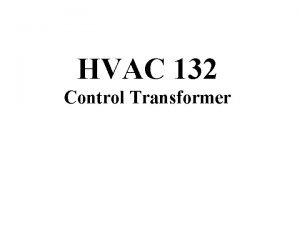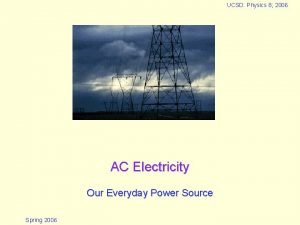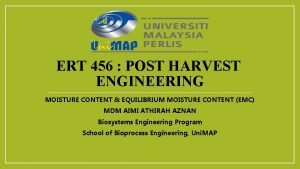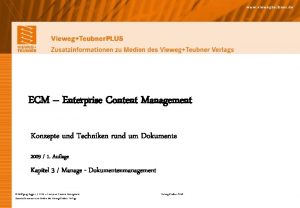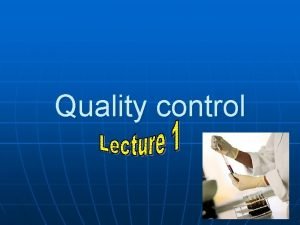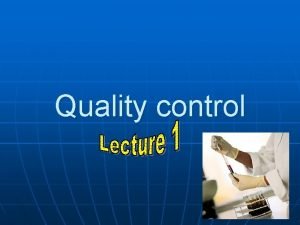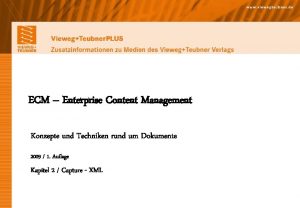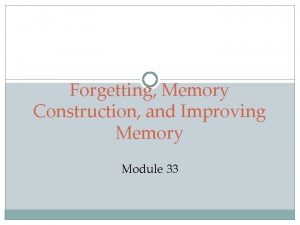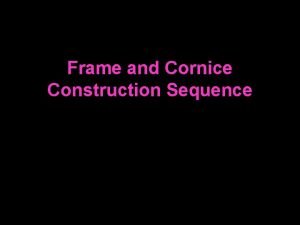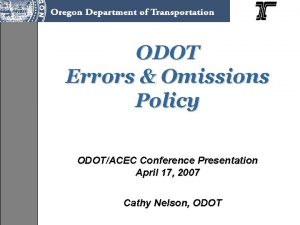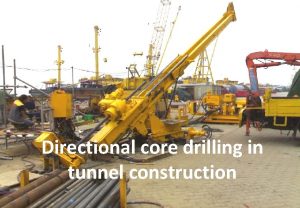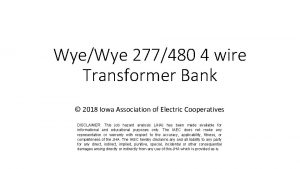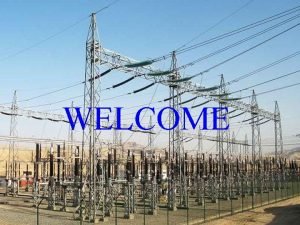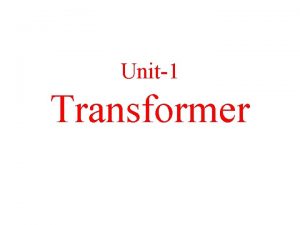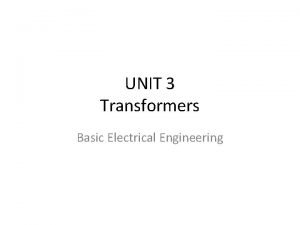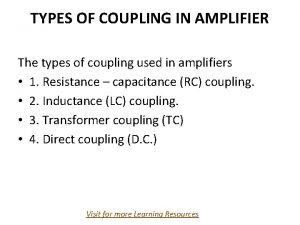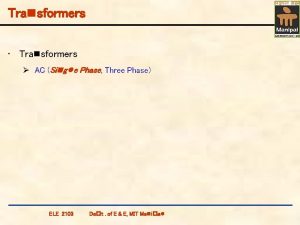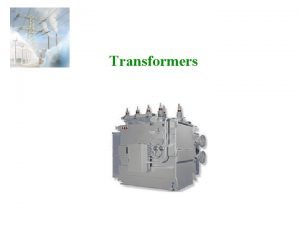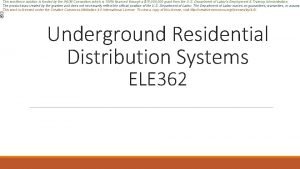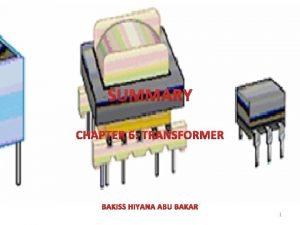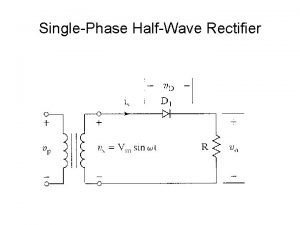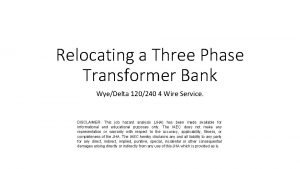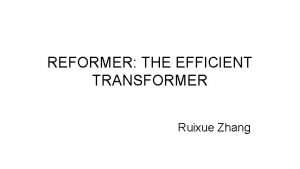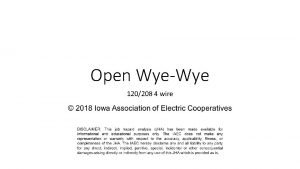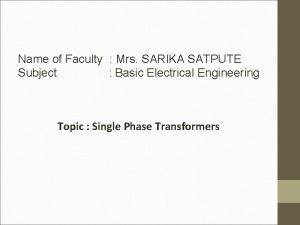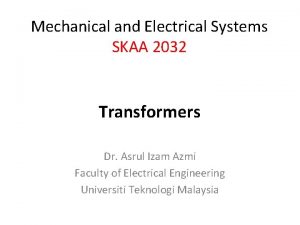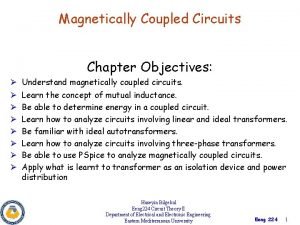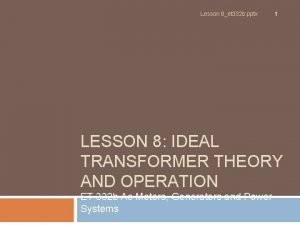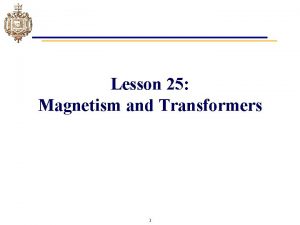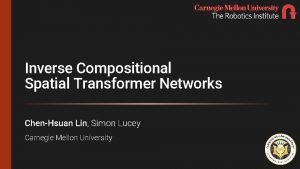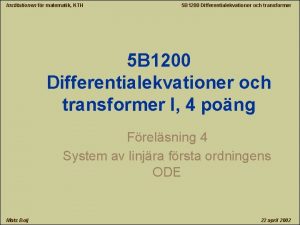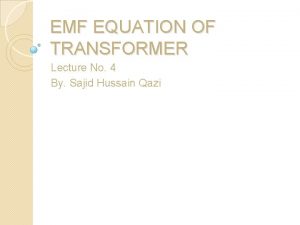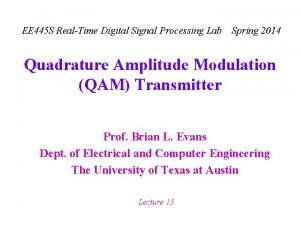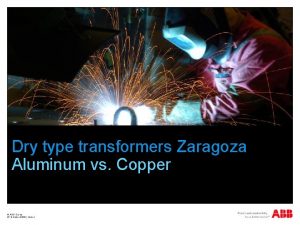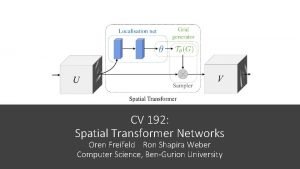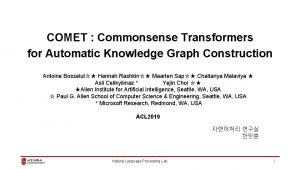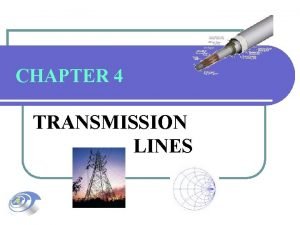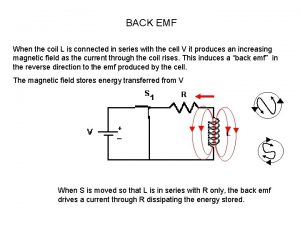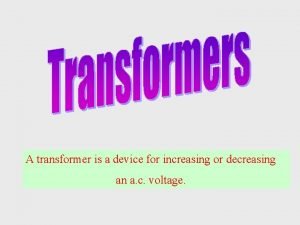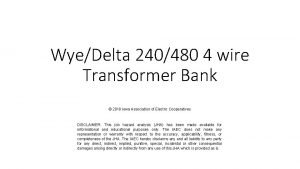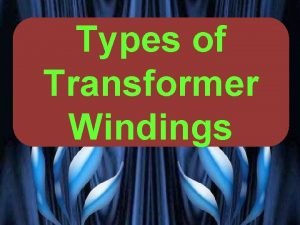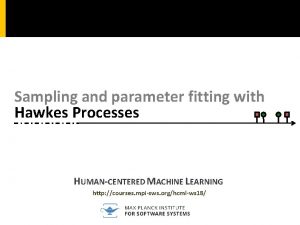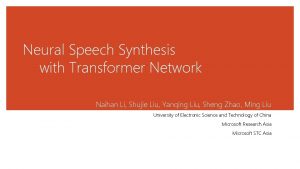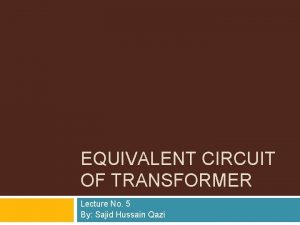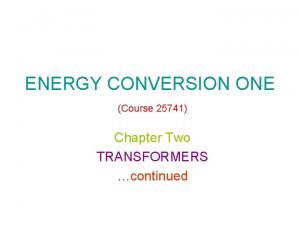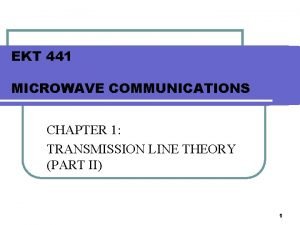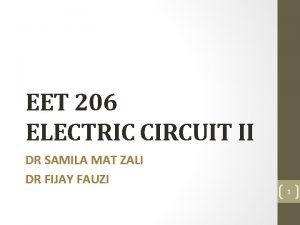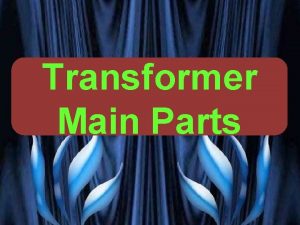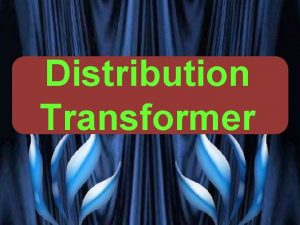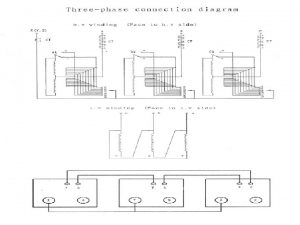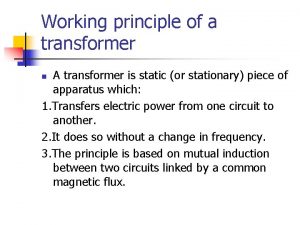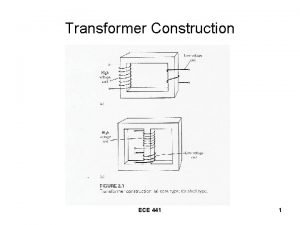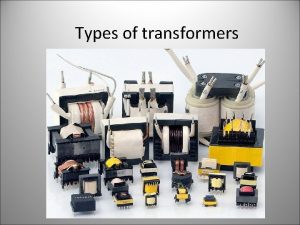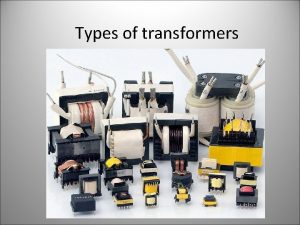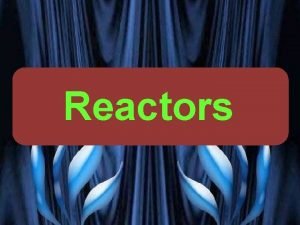TRANSFORMER CHAPTER8 CONTENT 1 Definition Construction Principle of


















































































- Slides: 82

TRANSFORMER CHAPTER-8

CONTENT 1 Definition, Construction & Principle of operation. 2 Types of Transformers. 3 E. M. F Equation and Voltage Transformation Ratio 4 Tests on Transformers –OC & SC Test. 5 Losses & Efficiency of a Transformer. 6 Three Phase Transformer and connections. 7 Auto Transformers& Instrument transformer –Principle & Working


Transformer - Definition A transformer is a static piece of apparatus by means of which electric power in one circuit is transformed into electric power of the same frequency in another circuit. It can raise or lower the voltage in a circuit but with corresponding decrease or increase in current.


Transformer

Construction

Construction The three main parts of a transformer are, • Primary Winding of transformer - which produces magnetic flux when it is connected to electrical source. • Magnetic Core of transformer - the magnetic flux produced by the primary winding, that will pass through this low reluctance path linked with secondary winding and create a closed magnetic circuit. • Secondary Winding of transformer – the flux, produced by primary winding, passes through the core, will link with the secondary winding. This winding also wounds on the same core and gives the desired output of the transformer.

Construction transformer sheet steel laminations assembled to provide a continuous magnetic path with minimum of air-gap included. The steel should have high permeability and low hysteresis loss. For this to happen, the steel should be made of high silicon content and must also be heat treated. By effectively laminating the core, the eddy-current losses can be reduced.

Construction plate varnish or lay an oxide layer on the surface. For a frequency of 50 Hertz, the thickness of the lamination varies from 0. 35 mm to 0. 5 mm for a frequency of 25 Hertz.

Principle of Operation Transformer works on the principle of mutual induction of two coils. When current in the primary coil is changed the flux linked to the secondary coil also changes. Consequently an EMF is induced in the secondary coil.

Principle of Operation

Types of Transformer (A) On the basis of construction 1. Core Type Transformer 2. Shell Type Transformer 3. Berry Type Transformer

Core Type & Shell Type Transformer

Berry Type Transformer

Types of Transformer (B) On the basis of their purpose 1. Step Up Transformer 2. Step Down Transformer (C) On the basis of type of supply 1. Single Phase Transformer 2. Three Phase Transformer



Three Phase Transformer

Types of Transformer (D) On the basis of their use 1. Power transformer 2. Distribution transformer 3. Instrument transformer 3. I. Current transformer (CT) 3. II. Potential transformer (PT)

Types of Transformer (E) On the basis of cooling employed 1. Oil-filled self cooled type 2. Oil-filled water cooled type 3. Air blast type (air cooled)

Difference Between Core & Shell Type Transformer Core Type Transformer Shell type transformer 1. The core has only one magnetic circuit. 1. It has two magnetic circuits. 2. Core has two limbs. 2. Core has three limbs. 3. It has less mechanical protection to coil. 3. It has better mechanical protection to coil. 4. It has better cooling since more surface is exposed to 4. Cooling is not very effective. atmosphere. 5. Natural cooling is provided. 5. Natural cooling cannot provide 6. This transformer is easy to repair. 6. This transformer is not easy to repair. 7. The winding is surrounded considerable part of core. 7. Core is surrounded considerable part of winding of transformer.

EMF Equation of a Transformer

EMF Equation of a Transformer Let, NA = Number of turns in primary NB = Number of turns in secondary Ømax = Maximum flux in the core in webers = Bmax X A f = Frequency of alternating current input in hertz (HZ) maximum value Ømax in one quarter of the cycle , that is in ¼ frequency second. Therefore, average rate of change of flux = Ømax / ¼ f = 4 f Ømax Wb/s

EMF Equation of a Transformer Now, rate of change of flux per turn means induced electro motive force in volts. Therefore, average electro-motive force induced/turn = 4 f Ømaxvolt. If flux Ø varies sinusoidally, then r. m. s value of induced e. m. f is obtained by multiplying the average value with form factor. Form Factor = r. m. s. value/average value = 1. 11 Therefore, r. m. s value of e. m. f/turn = 1. 11 X 4 f Ømax = 4. 44 f Ømax Now, r. m. s value of induced e. m. f in the whole of primary winding = (induced e. m. f. /turn) X Number of primary turns

EMF Equation of a Transformer •

Test on Transformer 1. Open Circuit Test 2. Short Circuit Test

Open Circuit or No Load test on transformer

Open Circuit test on transformer losses in transformer and parameters of shunt branch of the equivalent circuit of transformer.

Open Circuit test on transformer The two components of no load current can be given as, Iμ=I 0 sinΦ 0 and Iw = I 0 cosΦ 0 (no load power factor) = W / (V 1 I 0). . (W = wattmeter reading) From equivalent circuit of transformer (X 0 and R 0) can be calculated as X 0 = V 1/Iμ and R 0 = V 1/Iw.

Short circuit or Impedance Test on Transformer

Short Circuit test on transformer copper loss in transformer at full load and parameters of approximate equivalent circuit of transformer.

Short Circuit test on transformer W = Isc 2 Req where Req is the equivalent resistance of transformer Zeq = Vsc/Isc. Therefore, equivalent reactance of transformer can be calculated from the formula Zeq 2 = Req 2 + Xeq 2.

Equivalent Circuit of Transformer

Why Transformers are rated in k. VA? m a transformer depends on current, and iron loss depends on voltage. Thus, total transformer loss depends on volt-ampere (VA). It does not depend on the phase angle between voltage and current, i. e. transformer loss is independent of load power factor. This is the reason that transformers are rated in k. VA.

Three phase transformer connections configurations as (i) star-star, (ii) delta-delta, (iii) star-delta, (iv) delta-star, (v) open delta and (vi) Scott connection.

Star-star (Y-Y) transformers. reduced (as phase voltage in star connection is 1/√ 3 times of line voltage only). Thus, the amount of insulation required is also reduced. The ratio of line voltages on the primary side and the secondary side is equal to the transformation ratio of the transformers.

Star-star (Y-Y) Line voltages on both sides are in phase with each other. This connection can be used only if the connected load is balanced.


Delta-delta (Δ-Δ) transformers. Number of required phase/turns is relatively greater than that for star-star connection. he is equal to the transformation ratio of the transformers.

Delta-delta (Δ-Δ) This connection can be used even for unbalanced loading. age nother transformer is disabled, system can continue to operate in open delta connection but with reduced available capacity.


Star-delta OR wye-delta (Y-Δ) The the secondary winding is delta connected. substation end of the transmission line. transformation ratio. There is 30° shift between the primary and secondary line voltages.


Delta-star OR delta-wye (Δ-Y) nnected primary winding is The is connected in star with neutral grounded. Thus it can be used to provide 3 phase 4 -wire service. beginning of transmission line. transformation ratio. There is 30° shift between the primary and secondary line voltages.


Open delta (V-V) connections are made as shown in the figure below. transformers in Δ-Δ bank is disabled and the service is to be continued until the faulty transformer is repaired or replaced.

Open delta (V-V) connection ds ere erletallation ed be also can It of full three transformer bank is un-necessary. 57. 7% than that would be for delta-delta connection.


Scott (T-T) connection Two transformers connection. type this ofused are inthe One of transformers has centre taps on both primary and secondary windings (which is called as main transformer). The other transformer is called as teaser transformer. t conversion.


Instrument Transformers magnitude? which literally mean huge instruments.

Instrument Transformers ansformation there's using another way, ACOr property of currents and voltages. You can transform the voltage or current down with a transformer whose turns ratio is accurately known, then measuring the stepped down magnitude with a normal range instrument.

Instrument Transformers result with the transformation ratio. Such specially constructed transformers with accurate turns ratio are called as Instrument transformers. These instruments transformers are of two types – (i) Current Transformers (CT) and (ii) Potential Transformers (PT).

Uses of Instrument Transformer It is used for the following: 1. To insulate the high voltage circuit from the measuring circuit in order to protect the measuring instruments from burning. 2. To make it possible to measure the high voltage with low range voltmeter and high current with low range ammeter.

Current Transformers (CT) Current transformers are generally used to measure currents of high magnitude. These transformers step down the current to be measured, so that it can be measured with a normal range ammeter. A Current transformer has only one or very few number of primary turns. The primary winding may be just a conductor or a bus bar placed in a hollow core. The secondary winding has large number turns accurately wound for a specific turns ratio.

Current Transformers (CT) •

Current Transformer

Potential Transformer (PT) Potential transformers are also known as voltage transformers and they are basically step down transformers with extremely accurate turns ratio. Potential transformers step down the voltage of high magnitude to a lower voltage which can be measured with standard measuring instrument. These transformers have large number of primary turns and smaller number of secondary turns.

Potential Transformer (PT) A potential transformer is typically expressed in primary to secondary voltage ratio. For example, a 600: 120 PT would mean the voltage across secondary is 120 volts when primary voltage is 600 volts.

Potential Transformer

Auto Transformer An auto transformer is an electrical transformer having only one winding. The winding has at least three terminals. Some of the advantages of auto-transformer are that, they are • smaller in size, • cheap in cost, • low leakage reactance, • increased k. VA rating, • low exciting current etc.

Autotransformer

Construction An auto transformer consists of a single copper wire, which is common in both primary as well as secondary circuit. The copper wire is wound on a laminated silicon steel core, with atleast three tappings taken out. Secondary and primary circuit share the same neutral point of the winding.

Construction Variable turns ratio at secondary can be obtained by the tappings of the winding, or by providing a smooth sliding brush over the winding. Primary terminals are fixed. In an auto transformer, primary and secondary windings are connected magnetically as well as electrically.

Working An auto transformer has only one winding which is shared by both primary and secondary circuit, where number of turns shared by secondary are variable. EMF induced in the winding is proportional to the number of turns. Therefore, the secondary voltage can be varied by just varying secondary number of turns.

Working As winding is common in both circuits, most of the energy is transferred by means of electrical conduction and a small part is transferred through induction.

Autotransformer

Disadvantage The considerable disadvantages of an auto transformer are, any undesirable condition at primary will affect the equipment at secondary (as windings are not electrically isolated), Due to low impedance of auto transformer, secondary short circuit currents are very high, Harmonics generated in the connected equipment will be passed to the supply.

Losses in Transformer between input power and output power. An electrical transformer is an static device, hence mechanical losses (like windage or friction losses) are absent in it. A transformer only consists of electrical losses (iron losses and copper losses).

Losses in Transformer (i) Core loss or Iron loss • Hysteresis loss • Eddy current loss (ii) Copper loss

Core loss or Iron loss Eddy current loss and hysteresis loss depend upon the magnetic properties of the material used for the construction of core. Hence these losses are also known as core losses or iron losses.

Hysteresis loss is due to reversal of magnetization in the transformer core. This loss depends upon the volume and grade of the iron, frequency of magnetic reversals and value of flux density. It can be given by, Steinmetz formula: Wh= ηBmax 1. 6 f V (watts) where, η = Steinmetz hysteresis constant V = volume of the core in m 3

Eddy Current loss In transformer, AC current is supplied to the primary winding which sets up alternating magnetizing flux. When this flux links with secondary winding, it produces induced emf in it. But some part of this flux also gets linked with other conducting parts like steel core or iron body or the transformer, which will result in induced emf in those parts, causing small circulating current in them.

Eddy Current loss This current is called as eddy current. Due to these eddy currents, some energy will be dissipated in the form of heat.

Copper loss is due to ohmic resistance of the transformer windings. Copper loss for the primary winding is I 12 R 1 and for secondary winding is I 22 R 2. Where, I 1 and I 2 are current in primary and secondary winding respectively, R 1 and R 2 are the resistances of primary and secondary winding respectively.

Copper loss It is clear that Cu loss is proportional to square of the current, and current depends on the load. Hence copper loss in transformer varies with the load.

Efficiency of Transformer •

Condition for Maximum Efficiency Let, • Copper loss = I 21 R 1 • Iron loss = Wi

Condition for Maximum Efficiency

Condition for Maximum Efficiency Hence, efficiency of a transformer will be maximum when copper loss and iron losses are equal. That is Copper loss = Iron loss.

All Day Efficiency
 Chapter8 enterprice recource planning
Chapter8 enterprice recource planning Transformer is a static device
Transformer is a static device Difference between practical and ideal transformer
Difference between practical and ideal transformer Uses of transformers
Uses of transformers What is esp
What is esp Dynamic content vs static content
Dynamic content vs static content Curriculum construction
Curriculum construction Potential transformer definition
Potential transformer definition Is transformer a static device
Is transformer a static device Transformer hvac definition
Transformer hvac definition Transformer physics definition
Transformer physics definition Equilibrium moisture content definition
Equilibrium moisture content definition Ecm wiesbaden
Ecm wiesbaden Difference between disintegration and dissolution
Difference between disintegration and dissolution Content uniformity definition
Content uniformity definition Critical moisture content formula
Critical moisture content formula Concept of content analysis
Concept of content analysis Definition of content analysis
Definition of content analysis Content analysis definition
Content analysis definition Vorgehensmodell ecm
Vorgehensmodell ecm Enterprise content management definition
Enterprise content management definition What is memory construction
What is memory construction Cornice
Cornice Cambco
Cambco Lean construction définition
Lean construction définition Vertical construction definition
Vertical construction definition Errors and omissions definition construction
Errors and omissions definition construction Career cluster definition
Career cluster definition Definition of building economics
Definition of building economics Directional core drilling
Directional core drilling Portfolio construction definition
Portfolio construction definition Some ip transformer
Some ip transformer 277/480 bank
277/480 bank Insulation resistance test of transformer
Insulation resistance test of transformer Transformer efficiency formula
Transformer efficiency formula Transformers unit 3
Transformers unit 3 Advantages of rc coupling
Advantages of rc coupling Emf equation of transformer
Emf equation of transformer Transformer efficiency formula
Transformer efficiency formula A transformer is a device which
A transformer is a device which Transformer fittings and accessories
Transformer fittings and accessories Buck boost transformer seminar report
Buck boost transformer seminar report Transformer efficiency formula
Transformer efficiency formula Dead front vs live front transformer
Dead front vs live front transformer Non ideal transformer characteristics
Non ideal transformer characteristics Types of rectifier
Types of rectifier Wye-delta transformer bank
Wye-delta transformer bank Reformer: the efficient transformer
Reformer: the efficient transformer System100k
System100k Simbol pengubah
Simbol pengubah 277/480 transformer bank
277/480 transformer bank Copper loss in transformer formula
Copper loss in transformer formula Disadvantages of current transformer
Disadvantages of current transformer What is a transformer
What is a transformer Coupled circuits
Coupled circuits Ac theory 3 lesson 8
Ac theory 3 lesson 8 Transformer overview
Transformer overview Jesus the transformer
Jesus the transformer Chen-hsuan lin
Chen-hsuan lin Sats transformer
Sats transformer H1 h2 h3 transformer
H1 h2 h3 transformer Rectifier example
Rectifier example State the ideal transformer equation
State the ideal transformer equation 15 degree phase shift transformer
15 degree phase shift transformer Abb zaragoza
Abb zaragoza Spatial transformer networks
Spatial transformer networks Comet nlp
Comet nlp Quarter wave transformer smith chart
Quarter wave transformer smith chart Back emf in transformer
Back emf in transformer Transformer is a device which
Transformer is a device which 240/480 transformer bank
240/480 transformer bank Helical winding in transformer
Helical winding in transformer Strømvarmetab
Strømvarmetab Earthen berm
Earthen berm Transformer hawkes process
Transformer hawkes process Moct
Moct Nifps
Nifps Parallel tacotron 2
Parallel tacotron 2 Mci transformer
Mci transformer Practical transformer equivalent circuit
Practical transformer equivalent circuit Transformer energy conversion
Transformer energy conversion Quarter wave transformer
Quarter wave transformer Transformer dot convention
Transformer dot convention
